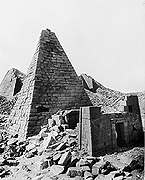Meroe was well known to the ancient world. Both the Greeks and Hebrews wrote about the greatness of Meroite people. The Meroitic period extended from 900 BC to AD 400.
Although the capitals of the Meroitic civilization changed during this period there was cultural continuity of Meroitic civilization for over a thousand years. The Meroites enjoyed much prosperity until they were conquered by Aezanes or Ezanes the King of Axum in 350 AD.

Up to 1100 BC Egyptians ruled the Meroites. From 1550 to 1200 BC there were many great Govenors or Viceroys of the Meroitic civilization, based at Napata. These officials were called "Teh-khet", 'Great One or 'Kings of foreign countries'.
As a result, the Egyptians and Meroites share many gods. In the Meroitic funerary text their is mention of Amun, Isis, Osiris and Mesh. Other Meroitic gods include Apedemek and Sebewyemeker.
The most important historical Monarchs were the Kings of Meroe.The burial place of the Meroitic Kings shifted from El Kurru (900-700 BC), to Nuri (700-300 BC) and finally Barkal-Meroe (300 BC to AD 400).
The Meroitic kings at various times in the 1000 year existence of the Meroitic civilization, ruled a territory extending from Kush into West Asia. These rulers became the XXVth Dynasty of Egypt.
The first ruler of this line of Kings was Kashta (700-751 BC). Kashta, successfully invaded Egypt and ruled much of the country from Thebes the capital of Upper Egypt. His son Piankhi completed the conquest of Egypt.
In 671 BC, Egypt was attacked by the Assyrians. The Assyrians forced the last Meroitic Pharaoh Taharqa from Tanis in the Egyptian Delta to Memphis. By 669 BC Taharqa was strong enough to push the Assyrians out of Egypt. But by 663 BC Tanwetamani, the nephew of Taharqa was driven out of Egypt by the Assyrians who sacked Memphis and Thebes. In the ensuing conflict many Egyptians were brutally murdered .
After the defeat of Tanwetamani the Meroites returned to Napata . At Napata the Meroitic kings ruled an empire from Kalabsha in Nubia, to Sennar and Kosti in the south.
By 540 BC, the Meroites moved their capital to Meroe, which had been a provincial town within the Kingdom. Meroe was the major center of iron working in Africa. From here caravans took Meroitic goods east and west into Africa, and countries bordering on the Indian Ocean.
The people of Meroe built beautiful temples, pyramids, and sculptured reliefs. The Meroitic temple consisted of small single chamber buildings with a colonnade surrounding them. All these structures were built of sun dried bricks.
The people of Meroe long had writing. First, they used the Demontic script and Hieroglyphics. By the second half of the first millennium BC , the Meroitic people had invented a cursive semi-alphabetic script. Hundreds of inscriptions written in this script survive up until today.

